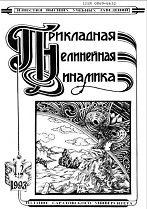|
SCIENCE FOR EDUCATION. METHODICAL PAPERS. HISTORY. PERSONALIA
"Computer metaphor'", interhemispheral asymmetry and species (spontaneous) knowledge of Homo Sapiens
N. Sh. Alexandrova
Sprachbrucke e.V. Berlin, Germany
Abstract:
The purpose of this article is to supplement the discussion in the field of research and modeling of the process of cognition first with data from neuropsychology and interhemispheric asymmetry, and second with reflections on species' (spontaneous) knowledge of Homo sapiens. I. The data of neuropsychology and interhemispheric asymmetry signify two differently directed and complementary ways of processing information and regulating the functions inherent in the brain. One of these methods is analytical computer-like information processing, which is necessary for voluntary learning, the other method provides holistic-simultaneous, imaginative, unconscious, and involuntary processing. The duality of cognitive strategies is clearly manifested in the psychological analysis of syndromes in the case of brain lesions, as well as various conditions in healthy people (for example, in the case of bilingualism). II. Biological existence, which is the basis for all other layers of life, is provided by species-specific behavior and knowledge. Presumably species knowledge manifests itself as 1 - Constant involuntary assessment of the surrounding world and adequate reactions to changes in the world: from ordinary reactions (step aside, add a step, etc.) to the ability to react without hesitation in dangerous situations. 2 - The ability to understand connections between phenomena without scientific calculations. The entire history of mankind speaks of the existence of such an ability. People survived without science and created science along the way. 3 - Deep knowledge (often without the ability to logically explain) of what is natural and useful for us as representatives of the Homo Sapiens species, and of what is unnatural and harmful. There are reasons to assume that species knowledge is the basis that determines the common behavior of people of different eras and cultures in everything related to the continuation of the family and the cultivation of a new generation. Species knowledge merges together in the process of development with the knowledge gained during training.
Keywords:
cognition, human behaviour, human communication, metaphor of a computer, species knowledge of Homo sapiens, neuropsychology, brain asymmetry.
Received: 16.11.2021
Citation:
N. Sh. Alexandrova, “"Computer metaphor'", interhemispheral asymmetry and species (spontaneous) knowledge of Homo Sapiens”, Izvestiya VUZ. Applied Nonlinear Dynamics, 30:3 (2022), 358–372
Linking options:
https://www.mathnet.ru/eng/ivp483 https://www.mathnet.ru/eng/ivp/v30/i3/p358
|

| Statistics & downloads: |
| Abstract page: | 68 | | Full-text PDF : | 90 | | References: | 5 |
|




 Contact us:
Contact us: Terms of Use
Terms of Use
 Registration to the website
Registration to the website Logotypes
Logotypes








 Citation in format
Citation in format 